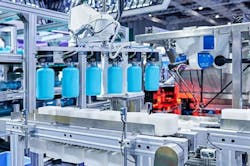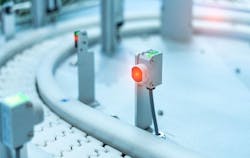Things to Consider When Selecting an Industrial Photoelectric Sensor
Simply put, sensors are the eyes and ears of industrial automation. Regardless of the application, automation is simply not possible in today’s manufacturing process without sensors. There are many different ways in which we measure our environment through sensors. Whether that is vibration, object detection, temperature or humidity, speed, strain or a hundred other different sensing technologies, sensors enable the world of industrial automation. One of the many different sensor technologies available is photoelectric sensors.
Photoelectric sensors are used in industrial applications to detect object presence. There are three types: through-beam, retroreflective and diffused. Depending on the sensor type, they can be used to detect materials such as wood, plastic, metal and glass.
READ MORE: Advanced Sensor Technologies Promote Safer, More Efficient Manufacturing Processes
Through-beam sensors utilize a transmitter node and a receiver node. The transmitter will be on one side of the beam, the receiver on the other. These two must be in alignment without obstructing the beam to work. With retroreflective, the sensor contains both the transmitter and receiver in the same unit. The sensor emitter projects the beam to a reflector. The reflector is aligned to reflect the beam back into the receiver.
In a diffused reflective sensor, the sensor again contains both transmitter and receiver in one unit. However, instead of needing a reflector to return the beam to the receiver, the sensor is directed at an object and the light returns to the receiver.
There are advantages and disadvantages to each sensor type. With a through-beam sensor, longer range, reliability and higher accuracy can be achieved. Areas such as wide door openings (e.g., garage doors or wide conveyors) can be monitored. This is due to light only needing to travel in one direction.
There are some disadvantages as well. For example, the cost is higher due to the need for multiple components being able to detect through thin, clear objects due to light refraction. With the need for two modules, setup can be more difficult as well. Factors like mounting space requirements, cable management and alignment can prove to be a challenge, depending on the application.
With retroreflective, the cost is lower and setup is easier, having only one module and a reflector. There is no need for additional cabling and power and alignment is easier, but distance becomes shorter. Applications for retroreflective include baggage conveyors at airports, vehicle detection at toll gates and some material handling applications.
READ MORE: Smart Sensors – A new era for strain gauge-based sensors
The disadvantage of retroreflective photoelectric sensors is the reflector. When the detected object is highly reflective, the sensor may fail to read the object. This can be avoided by adjusting the angles, but it is something to be aware of. With the beam being bi-directional, the detection distance is also shorter.
The diffuse photoelectric sensor is cheaper and there is only one point of installation. However, the detection distance is much shorter. Rather than relying on a reflector to bounce back the beam, the sensor relies on objects passing in front of the beam. The other downside is that depending on the material and color of the object being detected, the sensor may struggle to detect it.
What to Consider
When selecting the right photoelectric sensor for your needs, there are several things to review before deciding on one type over another. The following are a few points you should consider:
Location. The sensor’s location plays a significant role in the type of sensor technology you can use. What is the detecting range for your application or, to put it simply, how far away from the sensor is the object to be detected? Is there sufficient mounting space for the sensor module and bracket, and is cabling required for power and connectivity? What are the environmental conditions where the sensor(s) will be mounted? What level of ingress protection will the sensors need?
Beam size. Select a sensor with a beam size appropriate for the size of the target you are looking to detect. The target must be big enough that it will break the beam and trigger detection.
Sensor output. Two-wire sensors and three-wire sensors provide different outputs. In a two-wire sensor configuration, the sensor acts as a switch and will toggle the output on or off. With three-wire configurations, logic is required. In this case, the sensor triggers an event with a connected PLC using sourcing or sinking currents (PNP vs. NPN).
Output configuration. You will need to determine whether your sensor application would require a light-on, dark-on, light-off or dark-off configuration. Depending on the configuration needed it will help to select the proper sensor.
The circuit function will help to identify the type of sensor you need. Through-beam, retroreflective and polarized retroreflective sensors are all capable of light-off and dark-off output configurations. In contrast, diffuse reflective sensors are capable of light-on and dark-on configurations.
Excess gain. Excess gain is the measure of the minimum light energy needed to ensure proper triggering of the sensor. When selecting your sensor, you need to ensure there is sufficient excess gain to allow for proper detection. This will be especially important in dirty industrial environments.
When researching your sensor options, most manufacturers will provide an excess gain curve chart for both non-polarized and polarized sensors. These charts will provide maximum distance vs. maximum receiver gain based on a clean environment. There are levels to consider based on the cleanliness of the air in which the sensor will be operating.
READ MORE: Selecting the Right Sensor: A Guide for R&D and Electronics Design Engineers
Here are some examples to help explain the level of air contamination and how it impacts sensor operation and object detection.
- Clean air — ideal conditions, perfectly clean air
- Slightly dirty air — non-industrial areas
- Low contamination — warehouse, light manufacturing
- Moderate contamination — milling operations
- High contamination — heavy particulate, extreme washdown environments
- Extreme contamination — coal bins
Photoelectric sensors are indispensable tools in modern industrial automation, offering reliable and versatile object detection capabilities. Understanding the nuances of through-beam, retroreflective and diffused sensors is crucial for selecting the optimal solution for specific applications.
By carefully considering factors such as location, beam size, sensor output, output configuration and excess gain, engineers can ensure the successful integration of photoelectric sensors into their automation systems. The judicious choice of these sensors contributes significantly to enhanced efficiency, productivity and quality control in various industrial settings.
About the Author

Eric J. Halvorson
Senior Marketing Technology Manager for Automation and Control, DigiKey.
Eric J. Halvorson is a senior marketing technology manager for automation and control at DigiKey, a global leader in the distribution of electronic components and automation products worldwide. The company provides more than 15.6 million components from over 3,000 quality name-brand manufacturers.


